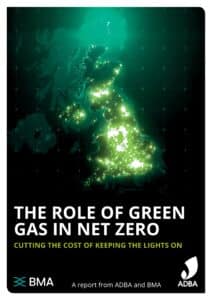In the run up to the ADBA Northern Ireland Conference, ADBA's Policy Lead Dr Gareth…
Biomethane, the premium economy flightpath to net zero
The International Energy Agency recently issued its second Outlook for Biogas and Biomethane. It concluded that Biogas and biomethane are seeing new momentum. Why? “For many energy policymakers today, there is a premium attached to projects that deliver on energy security objectives while reducing emissions and creating local value; this is a world of opportunity for biogases.”

The report forecasts that by 2040 biomethane could be meeting 25% of global gas demand from organic wastes and residues that can be processed with existing technologies, which do not compete with food for agricultural land.
Over 50 new policies have been introduced to support biogases since the IEA’s first special report on biogases, released in 2020. These range from relaxed state aid rules in support of strong biomethane targets and energy independence in Europe, to tax incentives in Brazil and blending mandates in India, identified as ‘epicentres’ of growth by the IEA.
Here in the UK the government’s Green Prosperity Plan includes key goals that can be met best through green gas expansion: accelerating net zero; increasing resilience, climate, energy and food security; protecting nature and clean water; and supporting British farmers.
According to analysis from ADBA/Business Modelling Applications, drawing on the AI-computer model used by Whitehall, the cost of meeting Britain’s net zero targets in 2050 could be nearly £300 billion less than official projections. The savings over the period to 2050 – equivalent to £415 for every household every year – would come about from a greater use of home-grown renewable green gas in the energy mix.
Green gas saves money by keeping our lights and heaters on when there is little wind and no sun, economising on much bigger investments in intermittent renewables that are otherwise needed to ensure security of supply. The government has said it will maintain a strategic reserve of gas power stations to guarantee security of supply, and these can run as well on biomethane as on fossil gas.
Further research from Alder BioInsights endorses the findings of the BMA study. This shows that by creating more flexible frameworks for biomethane production pathways the sector could be delivering by 120TWh by 2050.
Regenerative farming holds the key to unlocking this potential, with all the benefits this delivers in protecting biodiversity, preventing water and air pollution and maintaining soil health. Farming is responsible for 11% of the UK’s total greenhouse gas emissions.
Utilising cover and break crops from standard rotations as well as wastes delivers all these benefits. If we consider these circular economy wins and not just renewable energy generation, biomethane clearly achieves the IEA’s ‘premium’ action standard.
This approach would not only improve energy security and reduce reliance on fossil fuels but also deliver net negative emissions across energy and agriculture to support the nation on the trajectory to Net Zero. Feedstock should not be seen as a barrier to growth; it should be viewed as an enabler to a more resilient and sustainable future.
ADBA is lobbying hard for the government to take this approach as it develops its Future Biomethane Policy Framework, to replace the Green Gas Support Scheme.
When Parliamentary Under-Secretary of State (Minister for Energy Consumers) at DESNZ Miatta Fahnbulleh MP addressed the ADBA National Conference, she said, “We are looking at a transformative decade for this sector. You have set your sights high in terms of growth, and I share your ambition for the industry.”

Another key driver of the government’s clean energy mission is to create the technology and jobs of the future, to export around the world and build prosperity. Biogas is in the vanguard of the most important advances and exploration in green technology and production pathways, for green shipping fuel, sustainable aviation fuel, green methanol/ethanol and green hydrogen to name a few.
Biogas and biomethane production are also in the vanguard when it comes to the emerging markets for carbon removals and carbon farming. Carbon removals refer to Innovative approaches to capturing CO2, directly from the atmosphere and from biogenic emission sources. The world’s major emerging economies Brazil and India are waking up to the potential.
As the world shifts towards cleaner energy solutions, the UK government must seize this momentum and invest in biogas infrastructure, to take a leadership role in developing the policies and technologies that can deliver the green fuels, natural fertilisers and other bioresources of the future.

This will not only align the country with global sustainability goals but also boost economic resilience, create jobs and help achieve its own net-zero targets. Now is the time for the government to act and prioritise biogas in its green investment strategy.
To find out more about biogas and biomethane, production pathways and technologies, join us at the World Biogas Expo & Summit, at the Birmingham NEC on 9-10 July, presenting 150 exhibitors and over 80 speakers on policy and technology in the Summit and Engine Room Theatres respectively. www.biogastradeshow.com
